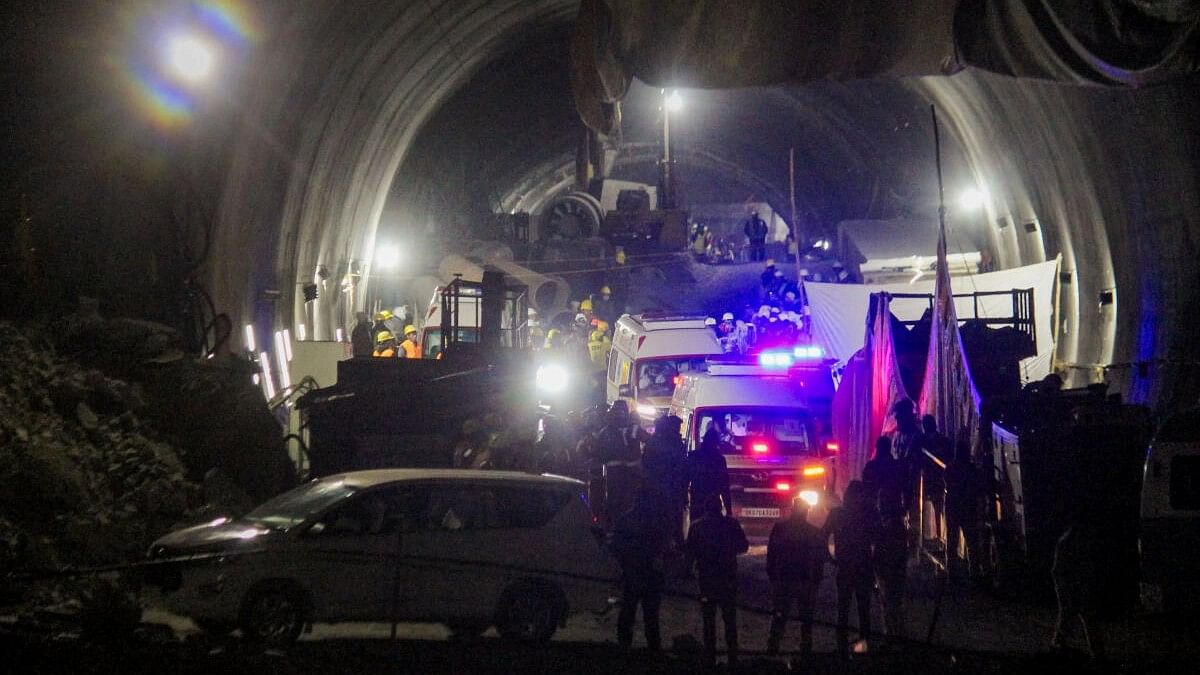
The Detailed Project Report mentioned that the alignment was “very unfavourable” in two segments.
Credit: PTI
41 workers trapped in the Silkyara-Barkot tunnel were rescued a week ago and a probe is under way to learn the circumstances that led to the incident. An Indian Express report has learnt that there were red flags over the geological challenges of construction, the level of risk, and how the project’s parameters were changed.
The National Highways & Infrastructure Development Corporation Ltd (NHIDCL), which is owned by the Ministry of Road Transport & Highways (MoRTH), conceived of the tunnel project in 2017, and according to official records, Delhi-based Technocrats Advisory Services Pvt Ltd (TASPL), which was hired to prepare the Detailed Project Report (DPR), submitted two reports that raised several red flags.
The report mentioned that the alignment was “very unfavourable” in two segments, adding that interlocked individual rock pieces could come apart due to redistribution of pressure due to excavation, making the tunnel’s ceiling and walls vulnerable to collapse.
Another key matter—‘Escape tunnels’—was not done according to the project plan. When asked why there were no specific escape tunnels, a senior project engineer explained that it was a "pragmatic decision" to change the project plan while it was still in the building phase.
On December 6, Union Highways Minister Nitin Gadkari said that there was a provision for a separation wall at the centre of the carriageway along with egress openings both for vehicles and pedestrians for escape during an emergency.
“Instead of leaving an escape channel on the left, it was decided to put the divider in the middle for single-way traffic on either side. This created more space for traffic and eliminated the risk of collision inside the tunnel,” a senior project engineer told the publication.
The geotechnical report also recommended several support measures, such as pipe roof umbrellas, pressure grouting and fully-grouted rock bolts, and a compulsory installation of a support system after each excavation cycle of 750-1000 mm to avoid unwarranted incidents.
Under the implementing agency NHIDCL, it was the duty of Hyderabad-based contractor Navayuga Engineering and its German advisor Bernard Grouppe, under the supervision of TPF Getinsa Euroestudios SL of Spain and New Delhi-based Rodic Consultants, to make sure that the safety measures were taken during excavation.
Only three months before the tunnel collapsed partially, in August, Bernard Grouppe had raised concerns. "Since the start of tunnel driving, the geological conditions have proved to be more challenging than predicted in the tender documents, thus confirming the results of the further exploration measures carried out at the beginning of the execution phase,” the note stated.
When asked if these "challenging" circumstances might have contributed to the tunnel collapse, the India operation manager for Bernard Grouppe declined to answer. There was no statement from Bernard Grouppe and Navayuga Engineering regarding the above issue.
As NHIDCL's Authority Engineer, TPF Getinsa Euroestudios SL (Spain) and Rodic Consultants Pvt Ltd (New Delhi) oversaw excavation, reviewed designs, ensured quality, approved materials, and monitored progress for the project. TPF Euroestudios SL, a Spanish company has been in India since 2006 through its subsidiary S N Bhobe & Associates Private Limited. It is interesting to note that S N Bhobe & Associates was the Authority Engineer for the Surat flyover which came apart, killing 10 workers in June 2014. There was no comment from TPF Euroestudios SL as well.
“We expected a more thorough DPR report but the surveys by Bernard (Grouppe) were useful. Tunnelling was a big challenge in such a shear and fracture zone and the alignment developed 21 small and big cavities. But the collapse happened due to the failure of the primary lining in an area that was cut more than four years ago and thought to have stabilised,” said a senior NHIDCL official.
He added that “all necessary precautions” were taken. “Wherever we found cracks and deformities, we went for re-profiling and allowed time before benching or final lining. There was no negligence on our part.”